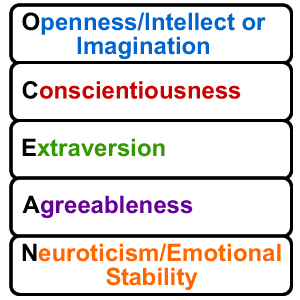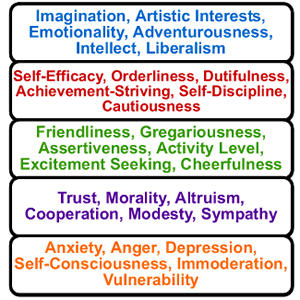Free Big 5 Personality Test - Five Traits and Thirty Subtraits


The Big 5 is the most commonly used personality model in academic psychology. Unlike personality type tests such as the Myers-Briggs or the Enneagram that determine which of the possible types is the best fit for you, the Big 5 test determines how much of each trait you have.
The Big 5, also referred to as the Five-Factor Model (FFM), is made up of five personality trait domains. The acronym OCEAN is often used to refer to the common labels of the five broad trait domains (the first letter of each trait taken together spells OCEAN). The trait domains sometimes go by other labels as well.
- Openness to Experience, Intellect or Imagination
- Conscientiousness
- Extraversion, Surgency
- Agreeableness
- Neuroticism, Emotional Stability
While most of the alternate labels used refer to a similar trait domain, there is an inverse relation between Neuroticism and Emotional Stability (i.e., a high score on Neuroticism implies a low score on Emotional Stability and vice versa).
Each Big 5 trait domain in turn may be further divided into six subtraits or facets.
- Openness to Experience
Subtraits/Facets: Imagination, Artistic Interests, Emotionality, Adventurousness, Intellect, Liberalism - Conscientiousness
Subtraits/Facets: Self-Efficacy, Orderliness, Dutifulness, Achievement Striving, Self-Discipline, Cautiousness - Extraversion
Subtraits/Facets: Friendliness, Gregariousness, Assertiveness, Activity Level, Excitement Seeking, Cheerfulness - Agreeableness
Subtraits/Facets: Trust, Morality, Altruism, Cooperation, Modesty, Sympathy - Neuroticism
Subtraits/Facets: Anxiety, Anger, Depression, Self-Consciousness, Immoderation, Vulnerability
Further breaking down each trait domain into subtraits or facets offers more detailed insight into an individual than can be offered by the broader trait alone.
As an example, while two people may score the same on the broader trait of Extraversion, looking at subtrait or facet scores within Extraversion can provide more insight. It might be that one person scores high on Friendliness while the other person scores high on Excitement Seeking. Looking at the scores on just the broader trait of Extraverstion would miss that their Extraversion derives from key differences.
Most tests available on the Internet measure only the Big 5 traits, but on PersonalityProbe.com you'll also find tests that get into more detail by measuring the Big 5 subtraits or facets as well.
Related Personality Tests
Click on any test title below to take that test.
Multiple Trait Tests
-
Big 5 Personality Test - Traits / Domains
A free 100 item personality test measuring all the Big 5 traits / domains. -
Big 5 Personality Test with Emotional Stability
A free 100 item personality test measuring all the Big 5 traits / domains with Neuroticism replaced by Emotional Stability. -
Big 5 Personality Test - Subtraits / Facets
A free 300 item personality test measuring all 30 subtraits / facets of the Big 5 traits. -
Big 5 Openness to Experience Test - Subtraits / Facets
A free 60 item personality test measuring all 6 subtraits / facets of the Big 5 trait Openness to Experience. -
Big 5 Conscientiousness Test - Subtraits / Facets
A free 60 item personality test measuring all 6 subtraits / facets of the Big 5 trait Conscientiousness. -
Big 5 Extraversion Test - Subtraits / Facets
A free 60 item personality test measuring all 6 subtraits / facets of the Big 5 trait Extraversion. -
Big 5 Agreeableness Test - Subtraits / Facets
A free 60 item personality test measuring all 6 subtraits / facets of the Big 5 trait Agreeableness. -
Big 5 Neuroticism Test - Subtraits / Facets
A free 60 item personality test measuring all 6 subtraits / facets of the Big 5 trait Neuroticism.
Single Trait Tests
-
Openness to Experience Test - Big 5 Trait
A free 20-item personality test measuring the Big 5 trait domain of Openness to Experience.-
Imagination Test - Big 5 Subtrait / Facet
A free 10 item personality test measuring Imagination, one of six subtraits or facets of the Big 5 Openness to Experience trait. -
Artistic Interests Test - Big 5 Subtrait / Facet
A free 10 item personality test measuring Artistic Interests, one of six subtraits or facets of the Big 5 Openness to Experience trait. -
Emotionality Test - Big 5 Subtrait / Facet
A free 10 item personality test measuring Emotionality, one of six subtraits or facets of the Big 5 Openness to Experience trait. -
Adventurousness Test - Big 5 Subtrait / Facet
A free 10 item personality test measuring Adventurousness, one of six subtraits or facets of the Big 5 Openness to Experience trait. -
Intellect Test - Big 5 Subtrait / Facet
A free 10 item personality test measuring Intellect, one of six subtraits or facets of the Big 5 Openness to Experience trait. -
Liberalism Test - Big 5 Subtrait / Facet
A free 10 item personality test measuring Liberalism, one of six subtraits or facets of the Big 5 Openness to Experience trait.
-
Conscientiousness Test - Big 5 Trait
A free 20-item personality test measuring the Big 5 trait domain of Conscientiousness.-
Self-Efficacy Test - Big 5 Subtrait / Facet
A free 10 item personality test measuring Self-Efficacy, one of six subtraits or facets of the Big 5 Conscientiousness trait. - Orderliness Test - Big 5 Subtrait / Facet
A free 10 item personality test measuring Orderliness, one of six subtraits or facets of the Big 5 Conscientiousness trait. - Dutifulness Test - Big 5 Subtrait / Facet
A free 10 item personality test measuring Dutifulness, one of six subtraits or facets of the Big 5 Conscientiousness trait. - Achievement Striving Test - Big 5 Subtrait / Facet
A free 10 item personality test measuring Achievement Striving, one of six subtraits or facets of the Big 5 Conscientiousness trait. - Self-Discipline Test - Big 5 Subtrait / Facet
A free 10 item personality test measuring Self-Discipline, one of six subtraits or facets of the Big 5 Conscientiousness trait. - Cautiousness Test - Big 5 Subtrait / Facet
A free 10 item personality test measuring Cautiousness, one of six subtraits or facets of the Big 5 Conscientiousness trait.
-
Extraversion Test - Big 5 Trait
A free 20-item personality test measuring the Big 5 trait domain of Extraversion.-
Friendliness Test - Big 5 Subtrait / Facet
A free 10 item personality test measuring Friendliness, one of six subtraits or facets of the Big 5 Extraversion trait. -
Gregariousness Test - Big 5 Subtrait / Facet
A free 10 item personality test measuring Gregariousness, one of six subtraits or facets of the Big 5 Extraversion trait. -
Assertiveness Test - Big 5 Subtrait / Facet
A free 10 item personality test measuring Assertiveness, one of six subtraits or facets of the Big 5 Extraversion trait. -
Activity Level Test - Big 5 Subtrait / Facet
A free 10 item personality test measuring Activity Level, one of six subtraits or facets of the Big 5 Extraversion trait. -
Excitement Seeking Test - Big 5 Subtrait / Facet
A free 10 item personality test measuring Excitement Seeking, one of six subtraits or facets of the Big 5 Extraversion trait. -
Cheerfulness Test - Big 5 Subtrait / Facet
A free 10 item personality test measuring Cheerfulness, one of six subtraits or facets of Big 5 Extraversion trait.
-
Agreeableness Test - Big 5 Trait
A free 20-item personality test measuring the Big 5 trait domain of Agreeableness.-
Trust Test - Big 5 Subtrait / Facet
A free 10 item personality test measuring Trust, one of six subtraits or facets of the Big 5 Agreeableness trait. -
Morality Test - Big 5 Subtrait / Facet
A free 10 item personality test measuring Morality, one of six subtraits or facets of the Big 5 Agreeableness trait. -
Altruism Test - Big 5 Subtrait / Facet
A free 10 item personality test measuring Altruism, one of six subtraits or facets of the Big 5 Agreeableness trait. -
Cooperation Test - Big 5 Subtrait / Facet
A free 10 item personality test measuring Cooperation, one of six subtraits or facets of the Big 5 Agreeableness trait. -
Modesty Test - Big 5 Subtrait / Facet
A free 10 item personality test measuring Modesty, one of six subtraits or facets of the Big 5 Agreeableness trait. -
Sympathy Test - Big 5 Subtrait / Facet
A free 10 item personality test measuring Sympathy, one of six subtraits or facets of the Big 5 Agreeableness trait.
-
Neuroticism Test - Big 5 Trait
A free 20-item personality test measuring the Big 5 trait domain of Neuroticism.-
Anxiety Test - Big 5 Subtrait / Facet
A free 10 item personality test measuring Anxiety, one of six subtraits or facets of the Big 5 Neuroticism trait. -
Anger Test - Big 5 Subtrait / Facet
A free 10 item personality test measuring Anger, one of six subtraits or facets of the Big 5 Neuroticism trait. -
Depression Test - Big 5 Subtrait / Facet
A free 10 item personality test measuring Depression, one of six subtraits or facets of the Big 5 Neuroticism trait. -
Self-Consciousness Test - Big 5 Subtrait / Facet
A free 10 item personality test measuring Self-Consciousness, one of six subtraits or facets of the Big 5 Neuroticism trait. -
Immoderation Test - Big 5 Subtrait / Facet
A free 10 item personality test measuring Immoderation, one of six subtraits or facets of the Big 5 Neuroticism trait. -
Vulnerability Test - Big 5 Subtrait / Facet
A free 10 item personality test measuring Vulnerability, one of six subtraits or facets of the Big 5 Neuroticism trait.